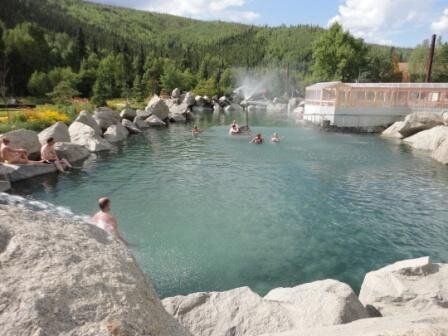
The "North" in North America is somewhat of a misnomer. The vast majority of Canadians and Americans for that matter live within a hundred miles of the 49th parallel. I have had the opportunity to travel to the north of Canada (in the summertime, yes I'm a wuss) and can fully attest to its majesty and beauty. The expanse of Great Slave Lake, the mountains and its rustic quality, speak to its uncommon splendor.
I love traveling in Canada, and the North has a particular attraction I believe for many. Recently I wrote a column about a land and cruise vacation we took to Alaska. Some of the comments chided me for "not traveling Canadian." Truth be told the largest portion of the water travel was through the inside straight of British Columbia. From the breathtaking Insular Mountain field to the great fjords that rival those of Norway, a trip through the real "North" should be on your bucket list.
And yes, we did decide this time around to travel our land portion in Alaska. A piece of the North I had heard much about but never visited. I'm glad we did.
In fact, a true highlight of our trip was a helicopter journey to the Herbert Glacier, North America's 5th largest ice field covering over 1500 sq miles and it wasn't without its heart-stopping excitement.
It was a cool crisp 10 degrees Celsius late summer morning in Juneau with patches of blue sky. However, the clouds hovering over the mountain range made a helicopter ride to the glacier still a bit iffy. Thankfully, with the arrival of the Coastal helicopter van came the good news that we were given the okay for liftoff.
Arriving at the heliport we were weighed (thankfully, they didn't read out the results) outfitted with glacier boots and led to our helicopter an Aerospatiale AStar. There we met our pilot Carlos Valdes-Roig, a former search and rescue pilot with the Florida County's Citrus Sherriff's office. He'd been piloting helicopters over 15 years in both the best and worst of conditions. Personally that brought me much comfort.
We were paired with another couple, Bill and Audrey, also from Florida. The women were seated in the front of the copter with Bill and I in the back. While I may be dating myself as I pulled myself into the seat adjusting the headset and fastening my seat belt, I couldn't help but be reminded of the old 60's TV show Whirlybird.
Heart pumping wildly the rotor above us turning furiously, the contraption that doesn't look like it should fly gently lifted off the ground. In what seemed like a matter of seconds we climbed nearly 5,000 feet hovering slowly along Mendenhall Lake, climbing suddenly up over Auke Mountain, picking up speed as we headed towards the glistening white peaks of McGinnis Mountain and Mount Stroller White.

Incredible view from Helicopter
The scenery below took my breath away. Steep snow capped mountains, bright blue sky as far as the eye could see and this was just the appetizer.
As we gently put down on top of the Glacier and carefully exited the helicopter our senses exploded; the beauty of the forces of nature descends all at once. Viewing the glaciers up close you can't help but notice two things; much of it is a deep sea blue and the rest is filled with grime and dirt. Our guide explains that the blue hue is caused due to the fact that on the colour spectrum blue is a short wavelength light not as easily absorbed by the ice and thus gets transmitted above the other colours. The dirt and grime is carried by the glacier itself as it moves down the mountain and ice fields.

Blue glacier

Author and wife Karyn on Glacier
It was noticeably cooler on the glacier, five degrees Celsius, but the warm reflecting sun and the regal beauty before us could have kept us there all day. Alas our pilot, noticing a heavy mist rolling in from the South, suggested it was time to leave. Buckled-in we lifted off and eerily within moments we were engulfed by a pea-soup thick fog.
Knowing we were surrounded by mountains on all sides and thousands of feet in the air but could not see a thing in front of us made me silently recite every prayer I ever learned in synagogue. So bad was the visibility that the Chief pilot at the helipad insisted that we return to the glacier and wait out the fog. Carlos, skillfully flying by instrument only, settled us back on top of the Glacier until the weather cleared.

Helicopter on glacier

Author with Helicopter pilot Carlos Valdez-Roig
In the ten days we spent on Canada's Inside passageway and Alaska we barely scratched its surface. Yes we learned a bit about the Native Athabaskan people indigenous to the area for thousands of years and we even experienced the Chena Hot springs 100 miles from the Arctic Circle used by Alaskans in -40 degrees Celsius. In the end it just left me in awe realizing how very small we are and how immense and incredible the world around us is.

Chena Hotsprings
In trying to understand the concept of wilderness I was especially struck by the definition of "wilderness" found in the American Wilderness Act of 1964.
A wilderness, in contrast with those areas where man and his own works dominate the landscape, is hereby recognized as an area where the earth and its community of life are untrammeled by man, where man himself is a visitor who does not remain...